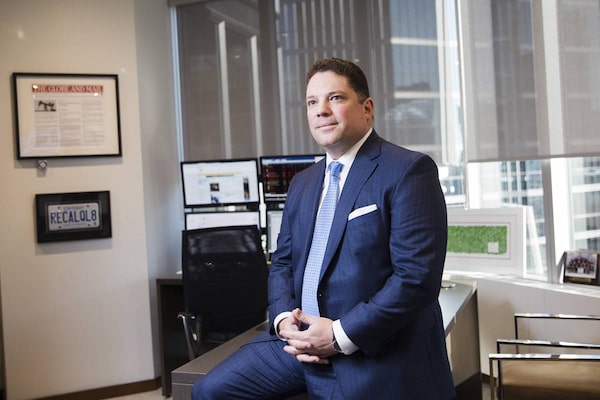The financial advice industry is going through so much change that perhaps it’s the advisors who need advice.
What exactly is the role of the advisor in the 21st century, where people live longer and technology is taking over investment buying, selling – and even strategy?
“The tools are certainly changing,” says Darren Coleman, senior vice-president and portfolio manager at Coleman Wealth, Raymond James Ltd. in Toronto.
Clients and their advisors will likely benefit, but the changes can also lead to confusion, he says. "With all the technological tools, it’s like going into an ice cream parlour with 5,000 flavours – it can be harder to choose what you really want.”

Canadians are living longer, so they need longer-term management of their portfolios, says Darren Coleman, senior vice-president and portfolio manager at Coleman Wealth.Michelle Siu/The Globe and Mail
It’s not just the technology. Investors’ expectations of how they will interact with advisors have changed, too. Smartphone apps are taking much of the grunt work out of portfolio building and management; they are also helping clients with fund research, balancing and technical forecasting.
As well, Canadians are living longer, so they need longer-term management of their portfolios. “The idea of people retiring and worrying about how much they’ll have when they’re 65 is gone. They’re worried about making their money last until they’re 95,” Mr. Coleman says.
At the other end of the client base are growing numbers of young people – digital natives who consider it natural to use an app to invest instead of calling an advisor.
Offering the most up-to-date tools for clients is “table stakes” for advisors now, says Markus Muhs, investment advisor and portfolio manager at Canaccord Genuity Wealth Management in Edmonton.
At the very least, clients should have an easy-to-use online and mobile access site so they can monitor their accounts, Mr. Muhs says.
If advisors are using more sophisticated technology, such as an artificial intelligence portfolio-management tool, they should work together with the client, he adds, combining human interaction with machine-driven advice.
A financial-planning portal for clients can help, too. "It allows clients to participate themselves in the financial planning process and view the results dynamically on their home computer or mobile phone,” he adds. “This is preferable to just getting a 60-page financial planning document.”
One of the biggest shifts for advisors will likely be the move to a fee-for-service model, says Tea Nicola, chief executive officer and co-founder of the Vancouver-based robo-advisory WealthBar.

Offering a fee-for-service plan enables advisors to give more "value-added, holistic services,” says Tea Nicola, CEO of Wealthbar.
“It’s more like how accounting or law firms operate. They are doing this to be more closely aligned with their clients’ actual needs,” she says. “Advisors over 55 can probably keep running their business as they do now, but younger advisors are moving in this direction [toward fee-for-service],” she says.
Instead of taking a percentage of a client’s portfolio, fee-for-service enables advisors to offer what Ms. Nicola calls “more value-added, holistic services” such estate planning, asset allocation and integrated tax planning.
Mr. Muhs says his own business started out being entirely based on embedded mutual-fund trailing commissions, which restricted him in the types of products he could offer. “I have since shifted most of my business to fee-based," he adds, with fees as a percentage of assets under management.
But newer clients are often looking to pay fees for each particular service. Younger clients find fee-for-service more cost-effective, “or they have the know-how to implement their investment strategy themselves and just want to pay for the holistic advice,” Mr. Muhs says.
Being a holistic advisor today can mean playing psychologist as well, Mr. Coleman says.
He tells the story of a client who was moving back to Canada with his wife and young children; the husband wanted to buy a particular house and the wife wasn’t sure she liked the neighbourhood.
“He wanted advice from me about the state of the economy and the housing market. I told him to hold off and rent and wait until they found a house that would make them both happy. My advice wasn’t really about the housing market at all,” Mr. Coleman says.
Factors driving change among advisors include new legislation and rules requiring disclosure, says Sandra Foster of Headspring Consulting.The Globe and Mail
The pace of change varies from advisor to advisor and firm to firm, says Sandra Foster, a Toronto-based financial author and president of Headspring Consulting Inc. In addition to technology, new legislation and rules requiring disclosure are driving change, she explains.
“Some advisors have fully committed to changing their business model and are taking a more holistic approach. Other advisors are making changes on an as-needed basis to follow the rules, such as those rules for disclosure and transparency in compensation,” Ms. Foster says.
“Perhaps these advisors hope to retire or sell their business before they have to commit to more fundamental changes,” Ms. Foster says.
The United States is good predictor of what advisors’ work will be like in the near future, Mr. Muhs says.
“South of the border, clients are placing more value on the relationship with their advisor and are seeking out independent advisors who operate as fiduciaries, as opposed to having their money with big banks or large brokerages,” he says.
In addition, “clients are becoming more fee-sensitive by the day, and financial advisors are having to really prove their value in terms of holistic advice.”